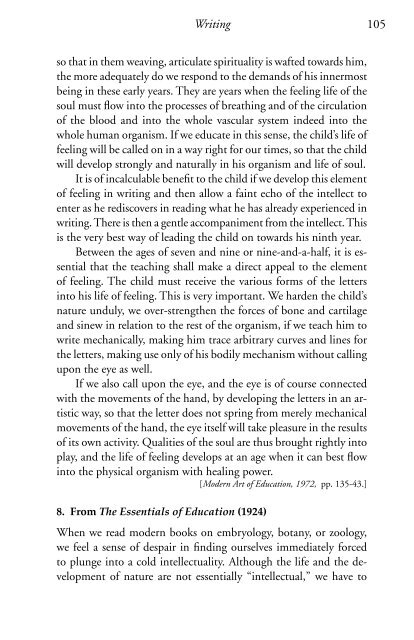Teaching Language arTs in The WaLdorf schooL
Teaching Language arTs in The WaLdorf schooL
Teaching Language arTs in The WaLdorf schooL
You also want an ePaper? Increase the reach of your titles
YUMPU automatically turns print PDFs into web optimized ePapers that Google loves.
Writ<strong>in</strong>g<br />
105<br />
so that <strong>in</strong> them weav<strong>in</strong>g, articulate spirituality is wafted towards him,<br />
the more adequately do we respond to the demands of his <strong>in</strong>nermost<br />
be<strong>in</strong>g <strong>in</strong> these early years. <strong>The</strong>y are years when the feel<strong>in</strong>g life of the<br />
soul must flow <strong>in</strong>to the processes of breath<strong>in</strong>g and of the circulation<br />
of the blood and <strong>in</strong>to the whole vascular system <strong>in</strong>deed <strong>in</strong>to the<br />
whole human organism. If we educate <strong>in</strong> this sense, the child’s life of<br />
feel<strong>in</strong>g will be called on <strong>in</strong> a way right for our times, so that the child<br />
will develop strongly and naturally <strong>in</strong> his organism and life of soul.<br />
It is of <strong>in</strong>calculable benefit to the child if we develop this element<br />
of feel<strong>in</strong>g <strong>in</strong> writ<strong>in</strong>g and then allow a fa<strong>in</strong>t echo of the <strong>in</strong>tellect to<br />
enter as he rediscovers <strong>in</strong> read<strong>in</strong>g what he has already experienced <strong>in</strong><br />
writ<strong>in</strong>g. <strong>The</strong>re is then a gentle accompaniment from the <strong>in</strong>tellect. This<br />
is the very best way of lead<strong>in</strong>g the child on towards his n<strong>in</strong>th year.<br />
Between the ages of seven and n<strong>in</strong>e or n<strong>in</strong>e-and-a-half, it is essential<br />
that the teach<strong>in</strong>g shall make a direct appeal to the element<br />
of feel<strong>in</strong>g. <strong>The</strong> child must receive the various forms of the letters<br />
<strong>in</strong>to his life of feel<strong>in</strong>g. This is very important. We harden the child’s<br />
nature unduly, we over-strengthen the forces of bone and cartilage<br />
and s<strong>in</strong>ew <strong>in</strong> relation to the rest of the organism, if we teach him to<br />
write mechanically, mak<strong>in</strong>g him trace arbitrary curves and l<strong>in</strong>es for<br />
the letters, mak<strong>in</strong>g use only of his bodily mechanism without call<strong>in</strong>g<br />
upon the eye as well.<br />
If we also call upon the eye, and the eye is of course connected<br />
with the movements of the hand, by develop<strong>in</strong>g the letters <strong>in</strong> an artistic<br />
way, so that the letter does not spr<strong>in</strong>g from merely mechanical<br />
movements of the hand, the eye itself will take pleasure <strong>in</strong> the results<br />
of its own activity. Qualities of the soul are thus brought rightly <strong>in</strong>to<br />
play, and the life of feel<strong>in</strong>g develops at an age when it can best flow<br />
<strong>in</strong>to the physical organism with heal<strong>in</strong>g power.<br />
[Modern Art of Education, 1972, pp. 135-43.]<br />
8. From <strong>The</strong> Essentials of Education (1924)<br />
When we read modern books on embryology, botany, or zoology,<br />
we feel a sense of despair <strong>in</strong> f<strong>in</strong>d<strong>in</strong>g ourselves immediately forced<br />
to plunge <strong>in</strong>to a cold <strong>in</strong>tellectuality. Although the life and the development<br />
of nature are not essentially “<strong>in</strong>tellectual,” we have to

















